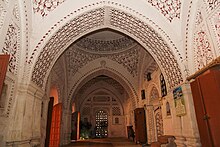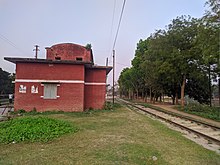Draft:History of Kushtia
In 1725 Kushtia was under Natore's zamindari and came to be recognized as part of the civil administration of the Rajshahi Faujdari of Kandanagar Pargana. Later British East India Company included Kushtia in Jessore District in 1776 . But in 1828 it was included in Pabna District. Kushtia Sub-Division was established in 1861 due to Neel Rebellion and in 1871 Kushtia Sub-Division with Kumarkhali and Khoksa Thanas was included in Nadia district. Before the partition of the Indian subcontinent, Kushtia was a subdivision under Nadia district. Kushtia District was formed in 1947. Then Kushtia district was formed with 3 subdivisions. These are Kushtia, Chuadanga and Meherpur. Then in 1984, when Chuadanga and Meherpur were separated as separate districts, the present Kushtia district was formed with 6 police stations of Kushtia subdivision.[1]
Naming history
[edit]Kushtia has an undisputed reputation as the cultural capital of Bangladesh since ancient times. But historians differ on how the name Kushtia came about. The most supported view is found in Hamilton's Gazette, published in 1820. That is, there was a time when jute was produced in large quantities in Kushtia. Jute was locally called Kosta (still called) or Kushti, from which the name Kushtia is derived. According to some, the name Kushtia is derived from the Persian word 'Kushtah' which means ash island. There is also an opinion that Kushtia city originated around the Kushti port during the time of the 5th Mughal emperor Shah Jahan.[2][3]
Mughal period
[edit]During the Mughal period, under Shah Suja, son of King Shah Jahan (1627-1657), Bengal was divided into 34 governments, each under the rule of a Faujdar. The presence of the Mahmudabad government in south-central Bengal at this time was 88 mahals (revenue-related divisions) and was located in an area called Mahmudpur (present-day Muhammadpur ) on the banks of the Madhumati River. Kushtia region was then under this government. In 1722, Nawab Murshid Quli Khan (1713-1725) divided Bengal into 13 chaklas instead of governments. Then the government of Mahmudabad i.e. Kushtia region came under Bhushana Chakla.[4] Kushti river port was established here during the reign of Emperor Shah Jahan.[5]
Many mosques built during the Mughal period can be found in Kushtia. These include-

British period
[edit]Infrastructure and industrial development
[edit]During the British period, Kushtia district improved a lot. In 1860, the British established the first railway station in Bangladesh.[6] Jagati Railway Station, connecting Kushtia directly with Kolkata.

Later this railway line was extended up to Goaland Ghat and communication with Dhaka became easy. Therefore, this region was considered as an ideal place for industries by the British. Renwick Jajneswar & Co Limited (1896), Mohini Mill (1908) were established during that period.[7] Kushtia Municipality was established in 1869. The British East India Company used the Kushti river port established during the reign of Emperor Shah Jahan . But urbanization started only after the arrival of indigo farmers and indigo growers in Kushtia.[5] Kushtia Sub-Division was established in 1861 due to Neel Rebellion and in 1871 Kushtia Sub-Division with Kumarkhali and Khoksa Thana was included in Nadia District.[1]
Anti-British movement
[edit]One of the Bengali leaders of the anti-British movement was Bagha Jatin (Jatindranath Mukherjee). He was born in Kaya village of Kumarkhali upazila.
Education system
[edit]Jagannathpur Secondary School (1944) is considered to be the oldest educational institution in Kushtia. After this comes Kumarkhali M.N. Pilot Secondary School which was established by Shri Yukta Babu Mathuranath Kundu in 1856.
Jagannathpur Secondary School and Goswami Durgapur Bahumukhi Secondary School are among the oldest educational institutions established in the rural environment of Kushtia . Not much information is available about Jagannathpur Secondary School. In 1860, Ray Bahadur Radhika Prasanna Mukherjee Goswami Durgapur Multipurpose Secondary School was established by the then high ranking official of Education Department of Nadia district .
Kushtia High School was established in Kushtia city in 1861. Kumarkhali Government Pilot Girls Secondary School was established in 1863 and its first headmaster was Harinath Majumder . Kushtia Government College was established in 1947.
All the educational institutions established during the Britil period-
Pakistan period
[edit]During the partition of British India in 1947, Kushtia was separated from Nadia district and emerged as a district of East Pakistan.[8] Its subdivisions were present Kushtia District, Chuadanga District and Meherpur District. Headquarter of Ganga-Kapotaksha Irrigation Project was established in Kushtia district in 1954 headed by the then SDO Maulvi Abdul Bari Biswas. Apart from this, after setting up several more government offices in Kushtia, the city started to develop again. Kushtia Zilla School was established in 1961.[9] Kushtia General Hospital was established in 1962 and became operational in 1963.[10] The Roads and Highways Department of Kushtia was established in 1962.[11] Govt. Commercial Institute now known as Kushtia Government Central College was established in 1967. Kushtia District Jail was established in 1968.[12]
Language movement
[edit]
A strong wave of language movement was also felt in Kushtia, an important town in the southwestern part of the country. The common people of Kushtia could not accept the sudden blow to the Bengali language. Although the language movement of the first phase of 1948 did not catch much wind in Kushtia. The language movement of 1948 saw some activity in Kushtia. However, it did not create much of a stir throughout Kushtia.[13]
References
[edit]- ^ a b "Emergence as a District". Bangladesh National Portal - Kushtia District. Retrieved 2024-03-20.
- ^ Shah Jahan Aman (2021-10-15). "Its glory-heritage is all over the pages of history". Bonik Barta. Retrieved 2024-03-17.
- ^ "Nomenclature of Kushtia". Bangladesh National Portal - Kushtia District Commissioner. Retrieved 2024-03-17.
- ^ Anwar Ali. Milan Sarker; Md. Monirul Islam (eds.). SARDHOSHATOBARSHO SMARAKGRANTHO 1869-2019 [Commemorative Book of 150 Years 1869-2019] (PDF) (in Bengali). Kushtia Municipality Office: Kushtia Municipality. p. 18. ISBN 978-984-34608-1-3. Retrieved 2024-07-31.
- ^ a b "Brief History of Kushtia District". Songgramer Notebook. Retrieved 2024-03-20.
- ^ SM Jamal (2021-11-15). "The first railway station in Bangladesh is the railway station in the world". Barta 24. Retrieved 2024-03-19.
- ^ National Portal of Bangladesh (June 2014), Industrial Institutions, Government of the People's Republic of Bangladesh, archived from the original on April 14, 2014, retrieved June 22, 2014
- ^ "ইতিহাস ঐতিহ্য সমৃদ্ধ সাংস্কৃতিক রাজধানী কুষ্টিয়া". দৈনিক সংগ্রাম. 2012-07-09. Archived from the original on 2016-03-06. Retrieved 2016-05-06.
- ^ "History of school". Kushtia Zilla School. 22 September 2018. Retrieved 2024-08-04.
- ^ "At a glance" (PDF). Bangladesh National Portal - Kushtia General Hospital. Retrieved 2024-08-04.
- ^ "এক নজরে কুষ্টিয়া সড়ক বিভাগ". Bangladesh National Portal - RHD, Kushtia. Retrieved 2024-08-04.
- ^ "Kushtia District Jail at a Glance". Bangladesh National Portal - Kushtia district jail. Retrieved 2024-08-04.
- ^ Ahmed Ishtiaq (2023-02-09). "Kushtia in language movement". Retrieved 2024-03-20.
{{cite news}}: Unknown parameter|wo5=ignored (help)
Bibliography
[edit]- Md. Rezaul Karim (December 2023). কুষ্টিয়ার প্রত্ননিদর্শন [Archeology of Kushtia] (in Bengali). 38/2A Banglabazar, Dhaka 1100: Gatidhara. ISBN 978-984-8950-41-8.
{{cite book}}: CS1 maint: location (link) - Dr. Muhammad Emdad Hasnain; Dr. Saria Sultana (2020). ধর্মীয় ইতিহাস স্থাপত্যে কুষ্টিয়া [Religious history is a struggle in architecture]. 7/3b. Literary Mir Musharraf Hossain Road, Kushtia 7000: Voice Publishing. ISBN 978-984-94435-0-6.
{{cite book}}: CS1 maint: location (link) - Anwar Ali; Milon Sarkar; Md. Monirul Islam (March 2019). সার্ধশতবর্শ স্মারকগ্রন্থ ১৮৬৯-২০১৯ [SARDHOSHATOBARSHO SMARAKGRANTHO 1869-2019] (PDF) (in Bengali). Kushtia: Kushtia Municipality. ISBN 978-984-34608-1-3. Retrieved 2024-07-31.





